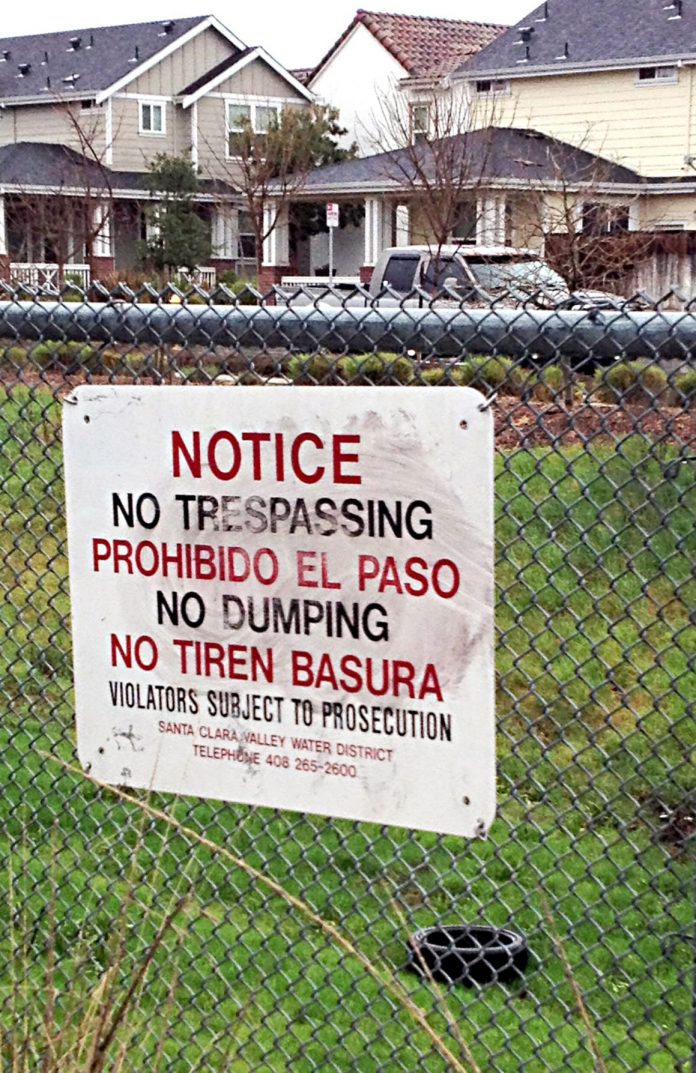GILROY—When Pat Vickroy called the city in December about mounting debris in a seasonal water channel that weaves through central Gilroy neighborhoods, he thought he’d stumbled on a problem he could tackle.
So, when he saw sleeping bags, tarps, food debris, a tire and other trash lining the bottom of the Miller Slough—at the Forest Street bridge—his instincts told him to grab garbage bags, put on a pair of gloves and start hauling the garbage himself.
“Then reality hit,” the Gilroy native said; it was not a job he could even attempt without dump trucks.
And although he made calls to city hall, no one came to clean up the debris and most of it washed downstream with the December rains.
“I gave the city a heads up plenty of times when the creek was dry to take action. They chose not to,” he said.
But the waterway is not the city’s jurisdiction—nor is it the Santa Clara Valley Water District’s responsibility, the agencies told the Dispatch.
District Field Operations Administrator Terri Gross said the slough at the Forest Street bridge is “definitely not” under its jurisdiction—even though district signage prohibits dumping. Gilroy Public Works Director Rick Smelser said it’s not the city’s property, either.
“It belongs to the property owners who live adjacent to the Miller Slough,” Gross said, pointing to a parcel map that shows the slough’s boundaries fall within privately owned parcels. “We don’t own any property in the area,” she said.
Ahead of the storm that hit the Garlic Capital Friday, Vickroy again called city hall in hopes they’d remove the debris. And while two employees assured him they would look into whether it was a city or county issue and get back to him, he never head back, he said Tuesday.
And the rain came.
Piles of clothing and trash swelled with moisture as it began Friday afternoon at the bridge. By Monday, the slough was fill with runoff and floating debris. The rains pushed lighter debris, such as paper and food wrappers to the surface while heavier refuse settled to the bottom.
“Nothing is getting done about it,” Vickroy said. “It makes me sick.”
Beneath the Forest Street bridge, someone had constructed a makeshift bed after re-arranging stones to create an alcove for protection from the wind. Graffiti covers part of the wall, while refuse lines the floor and clothing is laid out on the embankment—presumably to dry.
More than 20 feet from the Forest Street bridge, along the Miller Slough, a Santa Clara Valley Water District notice is posted to the gate designed to prevent entry to the area. It warns that trespassing and dumping are prohibited. The sign provides a phone number that directs to the water district.
It’s homeless encampments like those along the slough that generate tons of garbage pulled by crews from waterways and creek beds on city land. Last year, they hauled 38 tons of refuse from more than 100 encampments.
Dealing with the homeless who live in these areas is a balancing act between being compassion and keeping Gilroy’s waterway clean, Smelser said.
“We’re basically the arms when it comes to taking the debris away,” he said, adding transients are typically given advance notice prior to a camp being dismantled.
“We try to work with them when we do it because we’re dealing with peoples’ lives. We try to be as respectful as we can, but on the other hand, we have a responsibility to keep our creeks clean as we can and as well-maintained as we can.”
Local conservationist and president of the Coastal Habitat Education and Environmental Restoration, Herman Garcia, said he suggested public agencies work together to tackle the debris problem—one he said is made worse by the city’s approach to the homeless.
“The bottom line is everything flows into the Pajaro River and the Pajaro River dumps into the Monterey Bay just below Watsonville,” Garcia said. “The authorities go in and displace them on the spot. What they do is force them into the inner city or further out into other areas. They’re not going to go away and they have to stay somewhere.”
Vickroy suggested enlisting the homeless to clean the waterways up. But more important than assigning responsibility, he said, is making sure pollution is not tolerated.
“If it’s up to the property owners to keep the slough clean, hold them accountable then. It would be no different from an oil company dumping something into the ocean.”
“I’m not blaming them (the homeless) or pointing fingers at anybody…I’m just saying we need to take care of our creek,” Vickroy said. “Our way of living is diminished because of all the trash.”
“The bottom line is everything flows into the Pajaro River and the Pajaro River dumps into the Monterey Bay just below Watsonville.”
-Herman Garcia, conservationist














